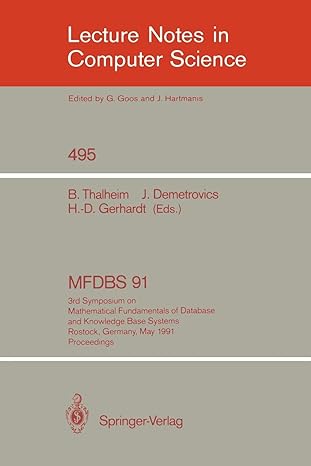Question
Question 1: Write six functions to code for the following six sorting algorithms in C++. Make your own header files to declare all the functions
Question 1: Write six functions to code for the following six sorting algorithms in C++. Make your own header files to declare all the functions you need to implement each of these sorting algorithms. For example, for quicksort, you will have a header file such as "quicksort.h", in which you will declare all the functions that you need to perform quicksort. Then you will include these header files in your main cpp program, in which you will implement and call all these functions. The input to all these sorts is the array of unsorted integers, the size of the array, and if required the start and end variables. The output of each of these sorts is the sorted array of integers printed on the console. Test these sorts with the unsorted array - A [89, 373, 1, 783, 23, 987, 12, 65, 28, 17]. Selection Sort - void SelectionSort(int array[], int arrayLength) {} Bubble Sort - void BubbleSort(int array[], int arrayLength) {} Insertion Sort - void InsertionSort(int array[], int arrayLength) {} Write a function to generate 10 unique dataset files of unsorted integers separated by a comma ",". E.g., 34, 32421, 124124, 67, 92, ... The sizes of these 10 datasets are (n) - 1000, 4000, 8000, 10000, 40000, 80000, 100000, 400000, 800000, 1000000. Generate random integers between 0 to 1,000,000 as the elements of each dataset. This function does not take any input arguments. This function generates and saves 10 ".txt" files. The output of this function is just a print statement to console that file generation completed. Write a function to read the data from the above-generated files and construct 10 unsorted arrays. This function does not take any input arguments. This function declares 10 arrays of sizes sufficient to store the content of the above-generated files and constructs these arrays by reading these files. The output of this function is just a print statement to console that unsorted array generation completed. Use the above-generated 10 arrays to give as the input to your six sorting functions and measure the duration of each function. Comment the statements you used to print the sorted array after each sorting function, as you need to measure only the time taken to sort. The output of each sort is the time taken in milliseconds to sort the given unsorted array. You can use "#include " or "#include" to measure the duration of a function in C++. While measuring the time you only need to measure the time taken by each sorting algorithm to convert the unsorted array into a sorted array. Note: The additional time taken, such as to construct your input unsorted array and to print your sorted array to console should not be included while measuring the duration of the sort. Repeat the above duration measurement of each sort 3 times to calculate the average duration of each sort for each array. Plot a graph for the duration of different sorting algorithms including Selection Sort, Bubble Sort, Insertion Sort, Quick Sort, Merge Sort, and Heap Sort. The x-axis of the graph will be the dataset size (n) (i.e., same as your array size), and the y-axis will be the average of the three executions for each dataset size. Thus, your x-axis will have ten labels and value of runtime on the y-axis for each label. Draw the above-described dataset size to runtime curve for the six sorting algorithms (Selection Sort, Bubble Sort, Insertion Sort, Quick Sort, Merge Sort, and Heap Sort) in the same graph sharing the same axis labels. Add Legend entry for each curve on the graph and use a different pattern like dotted, dashed, straight line, and different bullet dimensions and color for each curve of a sorting algorithm. Note: You have to generate datasets (i.e., unsorted arrays) only once and you can reuse the same datasets across three executions of each sort and also across different sorting algorithms.
Step by Step Solution
There are 3 Steps involved in it
Step: 1

Get Instant Access to Expert-Tailored Solutions
See step-by-step solutions with expert insights and AI powered tools for academic success
Step: 2

Step: 3

Ace Your Homework with AI
Get the answers you need in no time with our AI-driven, step-by-step assistance
Get Started


